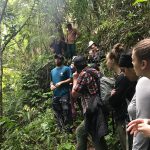Today, we headed back to the Parque Estadual da Serra do Mar in Picinguaba. Our first lesson? Field work goes on rain or shine.
The purpose of this trip was to further expand our knowledge about intertidal zones and to explore the Atlantic Rainforest that follows the coastline. We arrived slightly soggy, but ready for an adventure. We were led by Cristo, a local guide who presented traditional ecological knowledge passed down through familial generations in combination with scientific knowledge. We were also accompanied by Lao and Francisco, our guides who have been with us throughout the week. After arriving at the station, around 9 AM, we headed to the beach for a nice walk in gentle rain in the direction of an area where the intertidal zones are clearly visible. On the way to this area, we identified sand dollars, crab carcasses, jellyfish, a lively blue crab and even found a stingray egg case! Occasionally during the walk, we stopped to enjoy the local birdlife that feeds and nests near the Brazilian Coast. We spotted several species of tanagers, as well as frigate birds soaring overhead in the wind, and sandpipers scavenging the shore. After witnessing the tanagers flittering through the trees, Emily Landon had the opportunity to give her assigned species account for the green headed tanager (Tangara seledon). She educated her fellow students on natural history traits of the bird, as well as phylogenetic relationships and their conservation status.
Once we reached the intertidal zone, Cristo demonstrated his Traditional Ecological Knowledge on the species found in the intertidal zones and the information that has been passed down from his father. He managed to detach a small mussel that was latched onto one of the granite rocks of the infralittoral zone (the top zone). He explained how these creatures are able to survive ~6 hours without water, which is one of the reasons they are able to survive on the top zone in this type of habitat. He handed the mussels to the students and allowed us to look at it in more detail. Other organisms that were found around the rocks were snails, barnacles, crabs, and insects. We were allowed to explore the rocks for around an hour and then climbed a series of rocks and headed into the forest. Several stops were made along the way when Cristo identified plant species that are used for traditional medicine. For example, the black coconut tree (Pulmeria brejauva), is a large tree that is easily identified by the large black spines along the trunk and the small coconuts it produces. The medicinal uses of this tree include the leaves, which are used for acupuncture, and the coconut milk, which is used to treat hepatitis. We also learned a fun fact about how the trunk spikes were used by indigenous people in the past as arrow tips. These individuals would dip these spikes in poison to enhance their effects and ability to take down game. Unfortunately, due to a sudden downpour, our adventure was cut short and we headed back to the visitor’s station of the park to dry off and eat traditional Brazilian food.
After eating and experiencing the unpredictable weather that São Paulo is known for, we headed back to the Nucleo Santa Virginica for some free time! Some of the students took the opportunity to catch up on some schoolwork, but most enjoyed a well-deserved nap. Tonight, we had the first of our seminars that each student had prepared before the course. We were educated on the geology of the Brazilian coast by Emily P., and the phytogeography of the Atlantic coastal forest by Amelie. Tomorrow, students will continue to present their presentations with a focus on the Brazilian coast. These seminars will form the “bedrock” (geology joke!) of our education on the geography, biology, and history of Brazil and the Atlantic Costal Rainforest, which we will use to form our research projects in the coming days.
- On the beach
- Listening to Cristo on the trail.
- Egg case



Leave a Reply